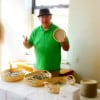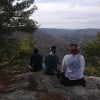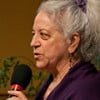By Amichai Lau-Lavie A year ago I was laying in a hammock on a Brazilian beach, planning a year’s worth of Shmita study and action that will rebrand this ancient sustainability practice rooted in the Land of Israel for new digital generations all over the world. Hovering between earth and sky provided the perfect setting to what I was designing: An adaptation of the Shmita concept beyond its original halachic, geographical and agricultural settings so that it will prove useful and meaningful to so many more of us. Now that the year is almost up and FallowLab, the project I designed, is starting its descent, it’s time to get back into the hammock and reflect on lessons learned and theories tested. Many creative projects and conversations emerged this year with varying degrees of success at wrestling with Shmita and offering ambitious renditions and new traditions. What sticks for future? Did we live up to the values of Shmita, did this year live up to expectations? Luckily I don’t have to go back to Brazil to find a reflection-friendly hammock. When I got back home last summer I set up a shmita garden in my Manhattan backyard: Stripped the garden of […]
Author Archive | Hazon
NY Finalizes Major Initiative to Expand Solar Access
From the Press Office of Vote Solar Diverse Coalition Applauds Cuomo Administration’s Commitment to Improving Community Health, Resiliency, Opportunity through Clean Energy Albany, NY – July 16, 2015 – Today the New York Public Service Commission (PSC) established an innovative Shared Renewables program that will expand consumer access to local solar, wind and other clean energy resources, particularly among low- and moderate-income New Yorkers. More than 70 local and national organizations join together in applauding state leaders for their commitment to a healthier, more resilient clean energy system that creates opportunities for all New Yorkers to thrive. “Solar is working for the Empire State in a big way. Record numbers of New Yorkers are harnessing sunshine to save on their energy bills, which is creating local jobs and reducing the need for traditional polluting power. This new program will empower even more communities, families and businesses to participate in that great solar success story,” said Sean Garren, Northeast Regional Manager for Vote Solar, a national solar advocacy organization. “We thank Governor Cuomo, his administration and the PSC for making equal access to solar a priority and for speeding our transition to a healthier, more resilient clean energy system.” New York […]
White House Honors Faith Leaders for Climate “Champions of Change”
Congratulations to Rabbi Marc Soloway, chair of Hazon’s Rabbinic Advisory Board, for being honored by the White House’s Champions of Change program! THE WHITE HOUSE Office of Communications FOR IMMEDIATE RELEASE WASHINGTON, DC – On Monday, July 20th, the White House will recognize twelve people of faith as “Champions of Change” for their efforts in protecting our environment and communities from the effects of climate change. These Champions have demonstrated clear leadership across the United States and around the world through their grassroots efforts to green their communities and educate others on the moral and social justice implications of climate change. The program will feature remarks by Environmental Protection Agency Administrator Gina McCarthy and Senior Advisor to the President Brian Deese. The Champions of Change program was created as an opportunity for the White House to feature individuals doing extraordinary things to empower and inspire members of their communities. The event will be live streamed on the White House website. To learn more about the White House Champions of Change program, visit www.whitehouse.gov/champions. Follow the conversation at #WHChamps. Huda Alkaff, West Bend, Wisconsin Huda Alkaff is the Founder and Director of the Islamic Environmental Group of Wisconsin (Wisconsin Green Muslims), formed in […]

Shmita Galore!
“Something miraculous happens when we stop. We get to experience the power that nature knows called dormancy…” – Rabbi David Ingber, sermon on Shmita, Hazon’s Shmita Sourcebook This year, Jewish communities in New York — and all across the world — embraced the biblical concept of Shmita. And JGF institutions led the way. With the help of JGF alumni shmita grants, Fellows created a variety of programs and events that highlighted Shmita values like releasing debt, eating thoughtfully, and reducing waste. Local Food and Gardening One of Shmita’s core teachings is to let the land lie fallow every seventh year, encouraging us to become more in sync with the earth’s natural cycles. In keeping with this message, many institutions developed programs centered around local food and gardening. Garden cultivation relieves stress and anxiety and improves memory. At Jewish Home Lifecare’s Sarah Neuman Center, a horticulture therapist led a workshop on garden-to-table eating. Seniors learned to grow vegetables and herbs, which provided not only fresh produce, but also healing. The JCC of Staten Island hosted its first Shmita Seder, using the Passover seder format to educate participants about the connections between Jewish and environmental values. A specially designed “Haggadah” guide walked participants […]
From Shmita to Hak’hel: Assembling on October 4
By Rabbi Arthur Waskow In the last several years, many societies and cultures have been stirred by the sense of a great planetary crisis caused by human action to overwork the earth — – the burning of fossil fuels scorching our global ecosystem, the human gobbling up of eco-space bringing on the extinctions of many other species, widespread deforestation weakening the Earth’s ability to absorb the overproduction of CO2, human behavior poisoning rivers and oceans and exhausting many watersheds. For some, these events have stirred two biblical memories and midrash: the identification of corporate “Carbon Pharaohs” that profit from bringing plagues upon the Earth; and for the first time in Jewish history, a serious exploration of how the Torah of the Shmita/ Sabbatical Year of rest for the land might be applied outside the Land of Israel –- indeed, universally. The realization of this powerful biblical way of understanding and addressing our generation’s crisis came soon enough before the Shmita year of CE 2014-2015 to stir rich discussion, but not soon enough to make the year a time of public transformative action — a real Shmita. As our present Shmita dwindles down, what can we do now, to keep our planet livable? Facing this crisis, 380 rabbis from every stream of Judaism have signed the Rabbinic Letter on the […]
Making Hummus with Shmita Values
By Michael Bomze On a weekly basis, I make hummus – very much at the mercy of area farmers, as I use fresh produce in each batch – and I donate all of the profits to Philadelphia urban farms. Admittedly, I do not think I ever had learned of the concept of Shmita before this year’s Hazon Philadelphia Jewish Food Festival – and I wasn’t initially sure how, in any capacity, I could apply the tradition of the Shmita to my 21st Century-paced life in a very large city. I think I’ve made some sense of it since November’s festival, though, and I offer my thoughts below. Though Shmita, a biblical mandate instructing farmers to let land lay fallow every seventh year, is a seemingly straightforward commandment, its implications are several. For instance, it isn’t Shmita that is the reason I’ve been preserving local produce in hummus, but thoughts and discussions regarding Shmita have helped me affirm what I am doing (and, if nothing else, the notion of Shmita has seemed a valid excuse to calm down my everyday life and to pay particularly close attention to my relationships with family, neighbors, and with nature). Regarding my hummus practices and the Shmita, perhaps the most obvious relationship is how each batch serves as […]
Love and Money in the Cycle of Release
By Rabbi Regina Sandler-Phillips The words of the Shema call for love of God “with all your me’od.” Me’od ordinarily means very-much, and is generally translated in the Shema as strength, might, or power. But ancient rabbis understood this power quite specifically: “Love God with all your money.” Money circulates—often inequitably, but it’s always moving among us. Talmudic rabbis, observing their own generations of changing fortune, declared poverty to be “a wheel that revolves in the world.” Given all the uncertainties of the financial wheel in spin, they called for regular attention to distributive justice: “Just as each small metal scale joins into a great armor-plate, so with tzedakah each and every coin joins into a great heshbon.” The Jewish ethical principle of heshbon (accountability) provides an immediate connection between ecology and economy, spirituality and social change. Every time we open our wallets or check our bank balances, we face choices of heshbon—and heshbon hanefesh ( “soul accounting”) includes personal finance. How are we literally spending each day of our lives? Rooted in the agricultural imperatives of the shmita cycle is a practice of heshbon accessible to all of us. The release of debts in the sabbatical year originally followed six years of regular tithing. No longer a form of […]

Raise a Glass to Greening: Creating a Sustainable Kiddush
Greening often happens in supply closets. On roofs. In the boiler room. Out of sight. To bring greening out of the shadows, it’s important to make it a visible part of your programming. For synagogues, weekly kiddushes offer the perfect opportunity to highlight greening work already underway and demonstrate that greening is a Jewish value. Kiddush, which means sanctification, was intended as a way to sanctify Shabbat and remind us to take a rest from our workday labors and enjoy the beauty of creation. But what could be a better way to sanctify the day than creating a healthier, less wasteful kiddush? Organizing a sustainable kiddush is an ideal first step for synagogues that have little experience in greening: it’s easier than a facility upgrade and requires less upfront effort and investment… but it can help the congregation get into better habits and build momentum for additional projects. For synagogues already steeped in greening, the kiddush – with its large, captive audience – offers an excellent opportunity to raise the profile of existing greening measures. Hosting a sustainable kiddush also provides a way to pilot changes in operations, testing their feasibility and congregants’ opinions as a springboard for broader change. […]

Where Are They Now?
Adamah Alumni Updates Josh Lichtman (Summer 2005) lives in New Orleans, has two young children, and is working on a Masters degree in urban planning. Steve Sherman and Glenn Katz (’11-’13) are working at a dairy in Tuscany for the second half of the Shmita year. Rachel Ackoff (Summer 2011) is working as a Senior Organizer at American Jewish World Service to mobilize the American Jewish community and other supporters of human rights to end violence against women and LGBT people globally. Tova Boehm (Summer 2006) owns and operates Short Winter Soups, a soup subscription business delivering locally grounded, inspired soups on a weekly basis in central North Carolina. (Rabbi) Adina Allen (Fall 2005), her husband Jeff Kasowitz and their little one Remy Ner are thrilled to have recently moved back to the Bay Area where they are launching a new Jewish learning and creative arts organization called The Jewish Studio Project. Jacob Perlman (Summer 2006) is in a masters program for occupational therapy in Minneapolis. Laura Held (Summer 2009) moved to Rochester, NY, to work at Foodlink as an Eat Smart New York (ESNY) Community Nutrition Educator. Emma Stuhl (Fall 2011) is getting her masters at the University of […]

Adamah Alumni Spotlight: Ahron Lerman, Fall 2006
It’s been a surprisingly long eight and a half years since I did Adamah in the fall of 2006. I was just 22 then, and had recently returned from a stint trading farm work for room & board as a WWOOFer in Kealakekua, HI. It occurred to me then that Judaism and natural cycles shared something more in common than I had been led to believe, and it was on that conviction that I applied to Adamah. Those three months spent ankle-deep in compost and soul-deep in community helped shape the mindset and language with which I’ve come to my current work as an Urban Forester with the Massachusetts Department of Conservation & Recreation’s Greening the Gateway Cities program in Holyoke, MA. As an urban forester, my job can be delightfully simple: plant trees. On the other hand, there is something profoundly unsettling about work whose success is ultimately based on maturity measured in decades. I approach work each day (sometimes humming an Avodat Lev melody) carefully balancing the attitude that those truths bring about. Besides its everlasting melodies, I feel Adamah’s most meaningful impacts when I go through the daily routines that comprise my life. I learned at Adamah […]

Omer Week Five: Olam Shana Nefesh
Wisdom from Rabbi Shir Yaakov Videography by Deana Morenoff and Michael Arginsky Rabbi Shir Yaakov is a teacher, singer, composer, designer, producer, and “aba” (Dad). He is the leader of an emerging spiritual community in the Hudson Valley, Kol Hai. In addition, he is a lead teacher in DLTI, and he serves both Romemu and ALEPH as Creative Director and is well known as a stage artist and liturgist performing with The Epichorus and Darshan. Working in both Jewish and multi-faith contexts, Shir Yaakov weaves a tapestry of Kabbalistic wisdom, contemporary songwriting and deep personal spirituality to offer a spiritual cultural Judaism that is contemporary, alive, and innovative. He has recorded and released four albums of original music. shiryaakov.com The 7-week period between the holidays of Pesach and Shavuot is called the Omer. For each of these 7 weeks, we will be making available one offering per week from 7 leaders of our upcoming Shavuot Retreat. Join us Memorial Day weekend for the Shavuot retreat to go deeper and get higher with these wonderful teachers. (Use early discount code EARLY10 through April 24th for 10% off.) In the meantime, enjoy our Omer experience!
Stop Now! ‘Shmita’ and Climate Change
by Mirele Goldsmith This article originally appeared on December 27, 2014 on the Shma website. Read the original article here. Imagine that you’re a wealthy landowner in ancient Israel. You know the shmita (sabbatical) year is coming and what’s required: You must stop planting and let your land lie fallow for the year. You must forego a year of profit. Not only that: Over the past few years, you have lent money to your poor neighbors and now you must forgive their debts so that your neighbors can also let their lands lie fallow. If they were obligated to pay you back, they would not be able to participate. These laws are good for the fertility of the land and for your neighbor’s livelihood and dignity. But observing shmita, and putting the community’s needs ahead of your own, requires a sacrifice from you. Would you do it? Fast forward to today: You live in one of the world’s richest countries and you depend on cheap energy extracted from the earth for your livelihood and your lifestyle. In neighboring countries, though, people are poor. They use little energy and they have little money to invest in new infrastructure. Will you try to […]

Omer Week Four: Here’s to Life
Wisdom from Rebbetzin Eve Ilsen Videography by ALEPH: Alliance for Jewish Renewal Rebbetzin Eve Ilsen is our featured teacher for this year’s Shavuot retreat. For the past decade she and her late husband Reb Zalman Schachter Shalomi זצ׳ל built this retreat into the amazing experience that it is today. Eve comes to us this year still in the first year of mourning for her beloved, and yet bringing an incredibly insighful and inspiring perspective on Life. This week’s video blog offers us a taste of her talents, her presence, and her power. Join us for the retreat and learn with her in person. Rebbetzin Eve Ilsen is a psychotherapist, teacher, storyteller and singer. She has studied closely with mythologist Joseph Campbell, Eutonia bodywork founder Gerda Alexander, and trained for years in Jerusalem in waking dream and the therapeutic use of imagery with Mme. Colette Aboulker-Muscat. Since returning to the United states in 1986, Ms. Ilsen has also worked in tandem with her husband of blessed memory, Rabbi Zalman Schachter-Shalomi זצ׳ל, co-creating the Wisdom School, co-leading workshops and partnering at holy day retreats. In 2008, she was ordained as a Rabbinic Pastor. These days, Eve is invoking transformative states by performing in concert, […]

Omer Week Three: Embodied Tiferet
Wisdom from Rachel Dewan, Certified Anusara Teacher, E-RYT500 Videography by Deana Morenoff and Michael Arginsky Rachel Dewan, Certified Anusara Teacher, E-RYT500 , is a graduate of the Yoga and Jewish Spirituality Teacher Training. and in addition to a full schedule of yoga classes, has been teaching Yoga Teacher Trainings, Prenatal Yoga Teacher Trainings, Yoga Therapeutics, and a wide variety of workshops since 2004. She has studied many different yoga styles and regularly immerses herself in a range of both Jewish and yogic texts and practices. It is Rachel’s ultimate goal as a teacher to cultivate a sense of community in her classes, bring a sense of fullness and joy to her students by inspiring them to expand to their highest possible potential both on and off the mat, and helping them to strengthen their connection to their own unique and divine nature. Her classes infuse dynamic asana and skillful pranayama (breathwork) and meditation, interwoven with deep teachings of the heart and spirit, designed to awaken the deepest longing of the soul to connect with it’s Source. Read Rachel’s thoughts on yoga and life. The 7-week period between the holidays of Pesach and Shavuot is called the Omer. For each of these 7 weeks, we will […]

Omer Week Three: Tiferet
Thoughts from Rabbi Ariel Burger, Designer of Adult Learning at PJ Library This article is from the Lippman Kanfer Foundation for Living Torah Blog 13 Ways of Looking At Tiferet 1. It was so beautiful I had to catch my breath. 2. It’s not the blending of kindness and discipline; it’s the tension between them. It is the love and the abyss between a father and a son after the Akedah. It is a feminine word but it is always associated with Jacob. It is untranslatable, not just beauty, not merely glory, a moving swirling river of colors and feelings. It receives in one hand and gives with the other. Imagine a dervish dancing, one hand cupped upward to catch spirit, the other open and relaxed, letting go, sharing. In receiving, giving; in giving, wholeness. 3. He didn’t give up when he saw he didn’t fit in, he had willingness to spare, so he wrestled with the angel until dawn. Yes he was wounded, I know, we all know, but wasn’t he beautiful as he staggered toward honesty? 4. He is the kind of man who stands and stares at one painting in the gallery for an hour. He is the smooth talker who says […]



